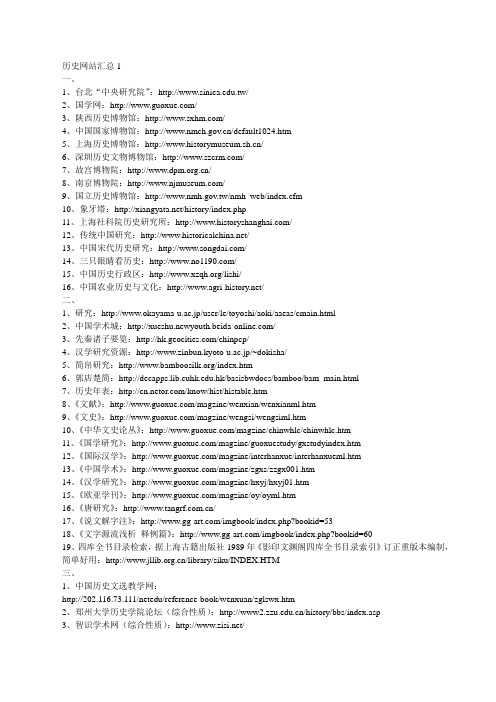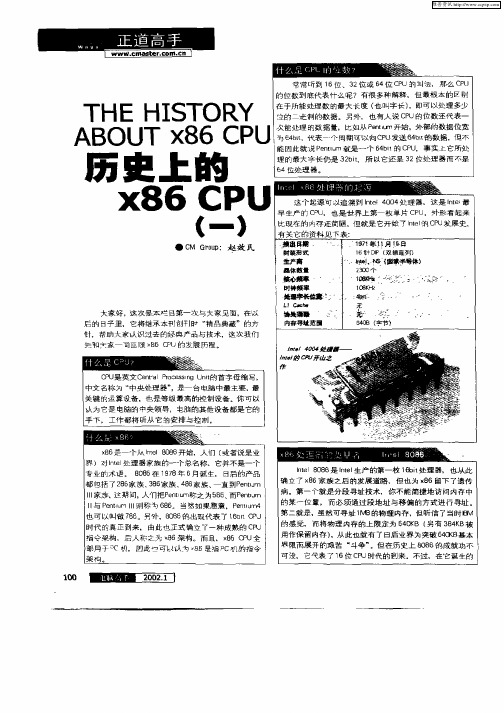C++的历史(英文版)
- 格式:pdf
- 大小:210.55 KB
- 文档页数:2

本草纲目(běn cǎo gāng mù)Compendium of Materia MedicaHealer who writes the book on TCMThe monumental Bencao Gangmu or “Compendium of Materia Medica”is the mostcomprehensive book ever written about traditional Chinese medicine. Published in 1596, thisbible contains 1,892 distinct herbs, 11,096 medical prescriptions and 1,160 illustrations.Its author, Li Shizhen (1518-1593), was one of the greatest physicians and pharmacologists inChinese history.Li was born in Qizhou in today's Hubei Province in central China. His grandfather was an itinerantdoctor who died before Li was born. Li's father was also a herbal doctor. However, due to the lowsocial status of herbal doctors at that time, he wanted his son to become an official in theimperial court. So, when Li was only 14, he took the imperial civil examination at the county level and passed.But he failed theprovincial-level exam three times.Eventually, Li gave up on officialdom and decided to follow in his father's footsteps to become aherbal doctor.In addition to practicing medicine, Li read all the classics and contemporary literature about TCM.However, in those medical books, Li found many glaring mistakes, conflicting information, wrongclassifications and ambiguities. He worried these errors would cause great problems or even costlives when they were used in treatment. So, he made up his mind to write a new bencaoor“materia medica.”His father warned him that it was a daunting task and it could take decades to re-examine everyherb and medicine in the country.However, young Li rose up to the challenge. In 1552, when Li was already 34, he started to workon his epic medical book Bencao Gangmu.First, he traveled to almost every corner of the country to talk to farmers, herbal doctors andpatients. During the day, he collected information about herbal medicine and gathered samplesof herbs and medicines. At night, he studied the samples, conducted experiments anddocumented their components and proved medical effects.There are myriad stories about how Li risked his own life by testing the effect of some herbs onhimself. One story goes that Li tasted a poisonous herb in the wilderness one day when he wasby himself. A few minutes later, he was so badly poisoned that he lay flat on the ground andcould hardly move. He thought this experiment would be his last.Then, some leaves fell from a nearby tea tree and several landed on Li's face near his mouth. Heused his tongue to roll the leaves into his mouth and began to chew. Miraculously, Li regained movement of his arms and legs and a while later, he was fullyrecovered.Then, he tried both the poisonous herb and the tea leaf againto determine their medical effects.It was not until 27 years later that Li completed his colossal work. In addition to field research, Liconsulted more than 900 medical books, nearly everything available in print.Li's book was written in about 1.9 million Chinese characters, divided into 16 volumes and 60orders. Li had not only improved the classification of traditional medicine, but also upgraded thecredibility and scientific value of biological classification of plants and animals.Li's method of biological classification was introduced about 200 years before Swedish botanistCarolus Linnaeus(1707-1778) proposed the modern system of biological nomenclature.In addition to herbs and traditional Chinese medicine, Li's book also covers topics such asbiology, chemistry, geography, mineralogy, geology, history and astronomy.At first, no one dared publish his book because Li criticized the alchemy for immortalitypromoted by some Taoist monks who had won the trust of emperors and imperial officials. It wasnot until three years after Li's death that a private print shop owner in eastern China printedBencao Gangmu.In 1606, the book was introduced into Japan and about 40 years later, it was translated into Latinby Michael Boym, a Polish missionary. Later it was translated into Korean, French, German,English and Russian and eventually many more other languages.。

中国成语故事英语成语故事是历史的积淀,是几千年以来人民智慧的结晶。
下面是小编搜集的关于中国成语故事英文版,喜欢就一起看看吧!成语:四面楚歌At the end of the Qin Dynasty(221-206 B.C.) the State of Chu and the State of Han fought for control for the country. Xiang Yu, the king of Chu, was besieged(包围) at a place called Gaixia by the Han army led by Liu Bang. Xiang Yu was in a desperate situation, with little food and only a few soliders. At night, the surrounding Han troops started to sing Chu folk songs. Xiang Yu was very surprised at this, and said:"Has Liu Bang occupied the whole of Chu? How can he have drafted so many Chu people into his army?" Then he fled together with the remainder of his forces.This idiom is used metaphorically to mean to be in a helpless and critical situation, surrounded by the enemy on all sides.项羽和刘邦原来约定以鸿沟(在今河南荣县境贾鲁河)东西边作为界限,互不侵犯。
后来刘邦听从张良和陈平的规劝,觉得应该趁项羽衰弱的时候消灭他,就又和韩信、彭越、刘贾会合兵力追击正在向东开往彭城(即今江苏徐州)的项羽部队。

历史网站汇总1一、1、台北“中央研究院”:.tw/2、国学网:/3、陕西历史博物馆:/4、中国国家博物馆:/default1024.htm5、上海历史博物馆:/6、深圳历史文物博物馆:/7、故宫博物院:/8、南京博物院:/9、国立历史博物馆:.tw/nmh_web/index.cfm10、象牙塔:/history/index.php11、上海社科院历史研究所:/12、传统中国研究:/13、中国宋代历史研究:/14、三只眼睛看历史:/15、中国历史行政区:/lishi/16、中国农业历史与文化:/二、1、研究:http://www.okayama-u.ac.jp/user/le/toyoshi/aoki/aaeas/cmain.html2、中国学术城:/3、先秦诸子要览:/chinpcp/4、汉学研究资源:http://www.zinbun.kyoto-u.ac.jp/~dokisha/5、简帛研究:/index.htm6、郭店楚简:.hk/basisbwdocs/bamboo/bam_main.html7、历史年表:/know/hist/histable.htm8、《文献》:/magzine/wenxian/wenxianml.htm9、《文史》:/magzine/wengsi/wengsiml.htm10、《中华文史论丛》:/magzine/chinwhlc/chinwhlc.htm11、《国学研究》:/magzine/guoxuestudy/gxstudyindex.htm12、《国际汉学》:/magzine/interhanxue/interhanxueml.htm13、《中国学术》:/magzine/zgxs/zzgx001.htm14、《汉学研究》:/magzine/hxyj/hxyj01.htm15、《欧亚学刊》:/magzine/oy/oyml.htm16、《唐研究》:/17、《说文解字注》:/imgbook/index.php?bookid=5318、《文字源流浅析释例篇》:/imgbook/index.php?bookid=6019、四库全书目录检索,据上海古籍出版社1989年《影印文渊阁四库全书目录索引》订正重版本编制,简单好用:/library/siku/INDEX.HTM三、1、中国历史文选教学网:http://202.116.73.111/netedu/reference-book/wenxuan/zglswx.htm2、郑州大学历史学院论坛(综合性质):/history/bbs/index.asp3、智识学术网(综合性质):/4、世界史:/5、中国历史在线:/shipin/default.asp6、天涯在线书库:/lishi.htm四、1、历史回廊:/2、中华历史网:/3、北洋水师:/index1.htm4、中国先锋青年历史论坛:/chinayouth.htm5、近代百年:/6、近代中国网:/7、联合早报网:/8、中国台湾网:/web/webportal/index.html9、1949新中国网站:/website/49cn/10、CNE3历史论坛:/11、K12历史论坛:/bbs/index.php?t=thread&frm_id=14&rid=647252&S=6701478d47b256559c2886ae3e7f aae012、血铸中华:/13、故乡历史:/lishi/14、论文网:/五、1、中青网历史博览:/encyclopedia/history/2、历史中的女人:/3、CCTV历史频道:/history/4、百度历史贴吧:/f?ct=&tn=&rn=&pn=&lm=&kw=%C0%FA%CA%B7&myselectvalue=1&word=%C0 %FA%CA%B7&tb=on5、TOM历史:/dynasty/6、扯淡网:/六、国际科学史学会(INTERNATIONAL UNION FOR THE HISTORY AND PHILOSOPHY OFSCIENCE/DIVISION OF HISTORY OF SCIENCE)美国科学史学会英国科学史学会/Science_Engineering/CHSTM/bshs/index.html日本科学史学会http://wwwsoc.nii.ac.jp/jshs/index-j.html英国李约瑟研究所国际数学史网上研究所(THE INTERNATIONAL VIRTUAL FOR HISTORICAL STUDIES OF MATHEMATICS) /德国马普科学史研究所http://www.mpiwg-berlin.mpg.de京都大学科学哲学科学史研究室http://www.bun.kyoto-u.ac.jp/phisci/index.html東京工业大学科技史科学基础論研究室http://www.histec.me.titech.ac.jp/course/中国科学院自然科学史研究所上海交通大学科学史与科学哲学系/shcp/index.html中国科学技术大学科技史与科技考古系http://202.38.82.235/index.htm内蒙古师范大学科学史与科技:/gb/mid/departmants/kxglykxx/index.htm清华大学科:/xueyuan/department/stsweb/stsintsinghua.htm西北大学数学与科学史研究中:/chinese/research/chms/index.htm中文图书馆/gosc.php?d=know&u=allbook&id=4中华万年网英文版:/english/main/index.htm台湾的历史(英文版).tw/taiwan/history/中国历史教与学http://210.39.136.39/history/文房四宝/category/stationery/金石篆刻/artchina_art/zhuanke/社会科学个人主页/search_dir/personal_homepages/sh/名著在线网/探索频道(英文)/汉龙网国宝精粹/national-treasure/美国白宫/中国的历史/history/welcome.html长城小站/网上历史研究/ger/历史网/时代书城/book/张角时空之旅/index.html闽南在线娱乐网/益凡公益图书馆书籍搜索/大唐书库/com/dtbook/近代中国网:/modern/BigClass.asp?BigClassID=1&BigClassName=学术研究&BigClassType=1百年中国论坛:/Forum/default.asp中国中俄关系研究会:/中国社会科学院边疆研究所:/chinese/s32_bjzx/s32_bjzx.htm清史研究所:/华东师大俄罗斯研究中心:/中国社会科学院史学书籍推荐这里存有大量的史学名著:/kxzz/yp.html楚文化网//forum/近代中国网论坛云南档案信息网:/indexH_8.htm历史风云网:/Index.html中国历史文化信息网:/。


一、罗马字的产生从公元前3000年左右开始,古埃及的人们就在使用文字(象形文字)表示神,人,动植物,自然界的形态(山,河等),来表示装饰品,武器,农具,日用品等的形状了。
该象形文字不仅仅给现在的字母表,还给阿拉伯文字,印度语族的文字带来了影响。
埃及人在用被称作纸草(papyrus)的植物所制成的纤维上书写文字。
Paper(纸)这个词便是源于papyrus.公元前2000—前800年间,海上贸易十分繁荣的腓尼基人,以埃及象形文字为基础,创造了腓尼基语的字母表。
公元前1000年左右,古希腊人又以腓尼基语的字母表创造了从左至右书写的24个字母的字母表。
Alphabet的词源即为希腊语的alpha(a)beta(B).罗马字字母表的确立得力于公元前800—500年间十分活跃的伊特拉斯坎人。
字母表的读法便是由他们的读法而来。
古罗马人用于拉丁语书写的字母表,是现在A—Z的26个字母中除去J,U,W后的23个字母。
G是罗马人为了与C的音[k]区别,表记[g]音而发明的字母。
进入10世纪后,U从V中独立出来,11世纪,为表现[w]音而采用了W,15世纪,J从I中分离出来。
关于英文字母起源世界上存在着许多讲法,但比较常见的讲法(根据Funk 《Word origins》一书)是起源于希伯来语。
应该讲这个讲法是有一定依据的。
因为《圣经》是西方文明的根源,而《圣经》所记录的正是犹太人(希伯来语)的历史。
而现在英语的二个重要语源希腊及拉丁语的祖先也是“希伯来语”。
希伯来语本身就是象形文字。
因此,现代英语中大量词汇隐现出象形文字的特征。
如A表“牛头”,暗示“尖,锋利”,如此引伸出“ace”尖,“aciform”类形,“acid”酸等各种表示“尖”的词汇。
但随着历史的不断发展,文明的不断提升,文字也融入大量文化的内涵。
因此,许多现代英语词汇已无法单纯从象形文字上推得,如“apogee”这地点,这个词,就由二部分组成“apo”表示“远离”+“gee”表示“土地”,其中apo来自于“阿波罗太阳神apollo”,表示“远征,远离”。

2023-2024学年第一学期福州市九年级适应性练习历史(满分:100分;完卷时间:60分钟;考试形式:闭卷)友情提示:请将所有答案填写到答题卡上!请不要错位、越界答题!一、选择题:本题共28小题,每小题2分,共56分。
在每小题给出的四个选项中,只有一项是符合题目要求的。
1.19世纪中期,英商可以携家眷在广州、厦门、福州、宁波、上海等五城市居住。
与这一现象相关的条约是()A.《南京条约》B.《北京条约》C.《马关条约》D.《辛丑条约》2.据图可知,该书叙述的内容是()A.太平天国运动B.维新变法运动C.义和团运动D.新文化运动3.1866年,左宗棠奏请创办福州船政局,认为中国“东南大利,在水而不在陆”,须“防海之害而收其利”。
由此可见,福州船政局的创办()A.是近代海防的产物B.得益于福州的地理环境C.揭开工业化的序幕D.体现了师夷长技的理念4.19世纪末,主要资本主义国家由先前向国外寻求商品市场转为寻求资本投资场所。
《马关条约》中体现这一变化的是()A.割地赔款B.协定关税C.开设工厂D.驻扎军队5.据表1可知,该校办学()表1 20世纪初期福建华英女书院中学课程设置(部分)A.宣扬维新思想B.注重科学技术教育C.强调以史为鉴D.体现中西文化交汇6.图中一系列历史事件主要反映的是()A.革命力量的汇集B.民主共和的潮流C.封建制度的终结D.政治中心的转移7.据表2可知,与外资厂矿相比,当时创办的华资厂矿()表2 1895-1913年外资厂矿、华资厂矿创办情况简表A.分布不均B.规模较小C.技术落后D.结构失衡8.“石库门,老弄堂……红船上,著纲领,百年航程第一步,驱散黑暗指方向”。
该童谣反映的历史事件是()A.中共一大B.中共二大C.遵义会议D.中共七大9.1926年9月,在中国共产党领导下,汉阳兵工厂工人响应“为革命的利益,不再为吴(佩孚)贼制造枪械”的号召,开展了大罢工。
这一大罢工()A.呼应了武昌起义B.声援了五四运动C.促成了国共合作D.支持了北伐战争10.1927年四一二反革命政变发生后,大批共产党员和革命群众遭到血腥屠杀。
2024-2025学年人教版(2019)选修3历史下册月考试卷573考试试卷考试范围:全部知识点;考试时间:120分钟学校:______ 姓名:______ 班级:______ 考号:______总分栏一、选择题(共6题,共12分)1、古巴导弹危机爆发后,核战争危机笼罩世界。
最终苏美达成协议,分别撤走部署在古巴和土耳其的导弹。
之后苏美首脑间的“热线”电话投入使用。
两国对此次危机的处理A. 是危机防控机制完善的结果B. 表明“冷战”出现新形式C. 体现保障根本利益下的妥协D. 促使美苏由对抗走向合作2、二战期间,盟国召开了一系列重要的国际会议,作出了一系列重大决定。
根据相关知识回答:对巴黎和会和雅尔塔会议相同点的叙述,不正确的是A. 都带有大国强权色彩B. 都损害了中国的主权和利益C. 据此形成了新的国际关系体系D. 英、法、美是会议的主要操纵国3、1970年尼克松在其对外政策报告中提出的以“伙伴关系、实力和谈判”为三大支柱的“新和平战略”,其内容不仅涉及美国与其盟国的关系,也涉及美国对苏联和中国的基本方针。
“新和平战略”的提出,主要是因为当时美国A. 意图放弃“冷战”政策B. 认识到大国间应相互依存C. 丧失了世界霸主的地位D. 实力相对下降面临着危机4、下表反映了英国农业人口的变化,导致这一变化的主要原因是A. 海外殖民活动的影响B. 工业化及城市化进程加快C. 资产阶级革命爆发D. 第一次世界大战的恶果5、1941年5月下旬,美国国务卿赫尔在致中国外交部长的信中表示:“希望在和平状态恢复的时候,能和中国政府以有步骤谈判和订立协定的程序,迅速地做到取消一切有特殊性质的权利。
”美国政府这一行为A. 表明美国开始改变中立立场B. 是绥靖政策的突出表现C. 履行了反法西斯同盟的约定D. 鼓励了中国的抗日斗争6、哲学家霍布斯说:“战争,并不只限于战斗行为;事实上,只要战斗意愿明白可知,这段时间都可算作战争。
History of C++The C++ programming language has a history going back to 1979, when Bjarne Stroustrup was doing work for his Ph.D. thesis. One of the languages Stroustrup had the opportunity to work with was a language called Simula, which as the name implies is a language primarily designed for simulations. The Simula 67 language - which was the variant that Stroustrup worked with - is regarded as the first language to support the object-oriented programming paradigm. Stroustrup found that this paradigm was very useful for software development, however the Simula language was far too slow for practical use.Shortly thereafter, he began work on "C with Classes", which as the name implies was meant to be a superset of the C language. His goal was to add object-oriented programming into the C language, which was and still is a language well-respected for its portability without sacrificing speed or low-level functionality. His language included classes, basic inheritance, inlining, default function arguments, and strong type checking in addition to all the features of the C language.The first C with Classes compiler was called Cfront, which was derived from a C compiler called CPre. It was a program designed to translate C with Classes code to ordinary C. A rather interesting point worth noting is that Cfront was written mostly in C with Classes, making it a self-hosting compiler (a compiler that can compile itself). Cfront would later be abandoned in 1993 after it became difficult to integrate new features into it, namely C++ exceptions. Nonetheless, Cfront made a huge impact on the implementations of future compilers and on the Unix operating system.In 1983, the name of the language was changed from C with Classes to C++. The ++ operator in the C language is an operator for incrementing a variable, which gives some insight into how Stroustrup regarded the language. Many new features were added around this time, the most notable of which are virtual functions, function overloading, references with the & symbol, the const keyword, and single-line comments using two forward slashes (which is a feature taken from the language BCPL).In 1985, Stroustrup's reference to the language entitled The C++ Programming Language was published. That same year, C++ was implemented as a commercial product. The language was notofficially standardized yet, making the book a very important reference. The language was updated again in 1989 to include protected and static members, as well as inheritance from several classes.In 1990, The Annotated C++ Reference Manual was released. The same year, Borland's Turbo C++ compiler would be released as a commercial product. Turbo C++ added a plethora of additional libraries which would have a considerable impact on C++'s development. Although Turbo C++'s last stable release was in 2006, the compiler is still widely used.In 1998, the C++ standards committee published the first international standard for C++ ISO/IEC 14882:1998, which would be informally known as C++98. The Annotated C++ Reference Manual was said to be a large influence in the development of the standard. The Standard Template Library, which began its conceptual development in 1979, was also included. In 2003, the committee responded to multiple problems that were reported with their 1998 standard, and revised it accordingly. The changed language was dubbed C++03.In 2005, the C++ standards committee released a technical report (dubbed TR1) detailing various features they were planning to add to the latest C++ standard. The new standard was informally dubbed C++0x as it was expected to be released sometime before the end of the first decade. Ironically, however, the new standard would not be released until mid-2011. Several technical reports were released up until then, and some compilers began adding experimental support for the new features.In mid-2011, the new C++ standard (dubbed C++11) was finished. The Boost library project made a considerable impact on the new standard, and some of the new modules were derived directly from the corresponding Boost libraries. Some of the new features included regular expression support (details on regular expressions may be found here), a comprehensive randomization library, a new C++ time library, atomics support, a standard threading library (which up until 2011 both C and C++ were lacking), a new for loop syntax providing functionality similar to foreach loops in certain other languages, the auto keyword, new container classes, better support for unions and array-initialization lists, and variadic templates.。